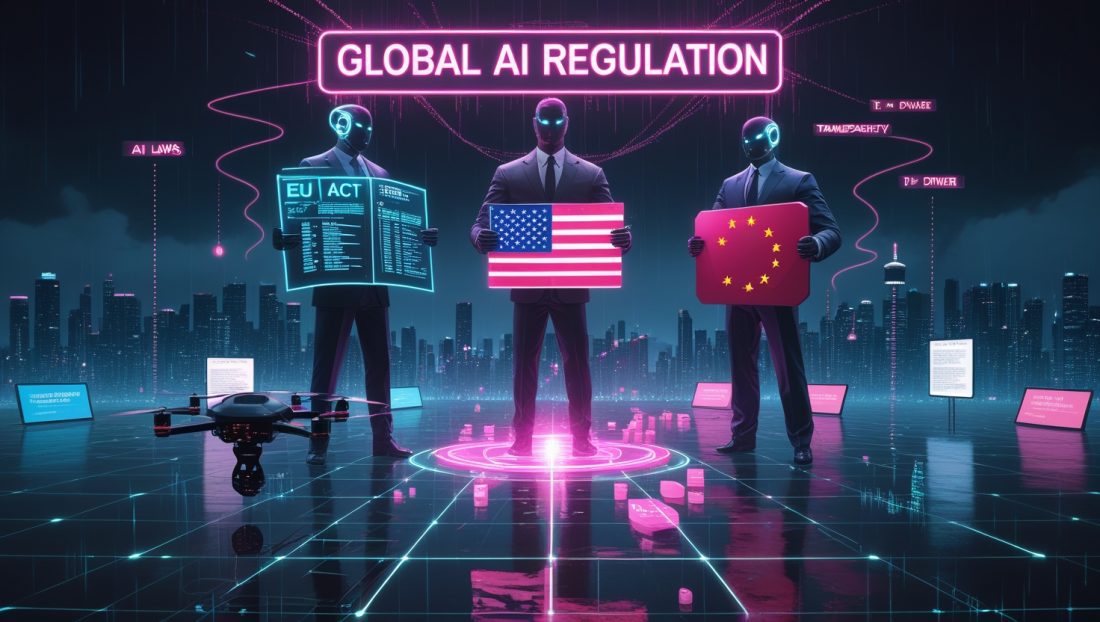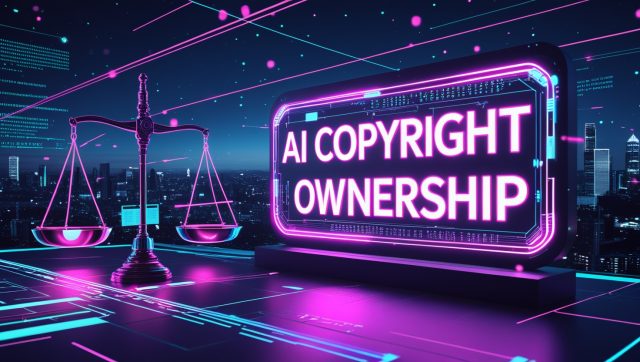The Unavoidable Crossroads
What happens when nations armed with competing AI rulebooks hold humanity’s future hostage?
In 2025, artificial intelligence operates your car, diagnoses diseases, and influences elections. Yet a seismic fracture divides global powers: no unified Global AI Regulation governs AI’s exponential growth. The EU champions human rights, the U.S. prioritizes innovation, and China merges control with progress. This regulatory fragmentation threatens economic stability, human rights, and geopolitical security. We stand at a crossroads where ethical frameworks aren’t academic exercises—they’re battle lines in a silent war for civilizational dominance.
Part 1: The Contending Titans – Three Visions Collide
1. European Union: Ethics as Enforcement
The EU’s AI Act (effective August 2024) imposes the world’s strictest compliance regime. Its risk-based hierarchy bans “unacceptable” AI (e.g., social scoring) and mandates exhaustive documentation for “high-risk” systems like medical diagnostics. A Berlin-based healthcare startup, MediScan AI, spent €387,000 retrofitting its cancer-detection algorithm to pass EU bias audits—delaying deployment by 11 months.
Thierry Breton, EU Commissioner, asserts that transparency isn’t negotiable: “If AI influences human lives, it must be explainable.”
Critics highlight unintended consequences: Compliance costs disproportionately burden smaller firms, cementing Big Tech’s dominance. The “Brussels Effect” leverages the EU’s market size to force global standards—a strategy detailed in our analysis of digital sovereignty trade-offs.
Why the EU’s AI Act Sparks Controversy
The EU’s rigorous approach stems from a deep-seated commitment to human rights, but it’s not without flaws. By prioritizing ethical AI governance, the bloc aims to prevent dystopian outcomes like unchecked surveillance. However, the high compliance costs—averaging €250,000 for startups—stifle innovation for smaller players.
For instance, a Dutch AI firm developing robotic pollination solutions faced delays due to mandatory bias audits, even though its tech targets environmental challenges, not human data.
This rigidity risks pushing innovation to less-regulated regions. The World Economic Forum notes that balancing ethical oversight with economic growth remains a global challenge, with the EU’s model often criticized for favoring caution over agility.
2. United States: Innovation’s Wild West
America’s regulatory landscape resembles a patchwork quilt. After the 2025 repeal of Biden’s AI Executive Order, federal oversight evaporated. States now forge conflicting laws:
- California’s Truth in AI Act requires watermarking political deepfakes.
- Texas exempts military AI from ethical reviews under its Freedom to Innovate Act.
- New York mandates algorithmic bias audits for hiring tools—penalizing firms like HireLogic with $2.3M fines in Q1 2025.
Silicon Valley investor Leah Chen observes: “Startups waste 40% of R&D budgets navigating 50 different rulebooks. This isn’t innovation—it’s obstruction.”
Why the U.S.’s Fragmented Approach Fuels Chaos
The lack of a unified AI governance framework in the U.S. creates a chaotic environment where innovation thrives but risks run rampant. For example, the absence of federal oversight has accelerated advancements like neural interface-controlled exoskeletons, which promise to revolutionize mobility but face inconsistent state-level safety standards.
This fragmentation confuses developers and endangers consumers, as seen in cases where unregulated AI in robotic surgery led to errors. According to a 2025 report by MIT Technology Review, the U.S.’s decentralized approach could cost the economy $500 billion annually by 2030 due to inefficiencies and legal disputes. A cohesive national strategy could unlock AI’s potential while mitigating harm.
3 China: Controlled Progress
China’s 2023 Generative AI Measures evolved into the Digital Sovereignty Shield in 2025. All AI-generated content must carry state-issued watermarks, and training data undergoes “patriotic alignment” reviews. When ByteDance’s Douyin AI accidentally promoted Tibetan cultural content in March 2025, regulators suspended service for 30 days.
Beijing’s strategy balances technological ambition with ideological control. Researcher Ming Zhao notes: “China views AI governance like nuclear containment—necessary for stability.”
Why China’s AI Control Model Raises Global Concerns
China’s tight grip on AI development prioritizes state control, but it’s a double-edged sword. By enforcing strict data alignment, Beijing ensures AI aligns with national interests, as seen in its deployment of robot cops for urban patrols.
Yet, this approach stifles creative freedom and raises ethical red flags globally. For instance, China’s AI-driven biohybrid insect technology has advanced environmental monitoring but sparked concerns over surveillance overreach. A 2025 analysis by Foreign Policy highlights how China’s model could set a precedent for authoritarian regimes, potentially undermining global trust in AI systems.
Part 2: Real-World Fallout – Industries in the Crossfire
1 Healthcare: Lives vs. Liability
Sweden’s Karolinska Hospital suspended its AI sepsis predictor after EU regulators flagged opaque decision-making. Meanwhile, a Texas clinic using unregulated AI misdiagnosed 12 patients with rheumatoid arthritis. Dr. Amara Singh (Mayo Clinic) warns: “Inconsistent standards cost lives. We need global baselines for medical AI.”
2 Finance: Algorithmic Bias Goes Global
In 2025, Kenya’s mobile loan platform Tala faced EU sanctions for using “high-risk” credit-scoring AI without bias audits. Conversely, Zimbabwe adopted unregulated Chinese AI loan tools—triggering a 300% spike in loan defaults due to discriminatory algorithms.
3 Military AI: The New Arms Race
The U.S. Department of Defense fast-tracked Project Sentinel—autonomous drones exempt from ethical reviews. Meanwhile, NATO’s “Red Lines” framework bans AI-powered lethal decisions without human oversight. This schism complicates joint operations, as seen in the 2025 Mediterranean drone incident where conflicting protocols nearly caused friendly fire.
Part 3: Grassroots Resistance – Citizens Fight Back
1 Worker-Led Movements
Amazon warehouse workers in Birmingham, UK, struck for 18 days in January 2025, forcing the company to disable productivity-tracking AI. Their slogan: “Algorithms don’t bleed; we do.”
2 Algorithmic Auditors Emerge
Barcelona’s Algorithmic Justice League—a citizen collective—exposed racial bias in police surveillance AI. Using the EU’s “right to explanation” clause, they compelled the city to release audit trails showing false positives targeted immigrant neighborhoods.
3 Data Sovereignty Networks
Indigenous tribes in Canada launched the First Nations Data Cloud—a sovereign AI trained on culturally curated datasets. This counters exploitative practices like mining companies using AI to identify tribal mineral claims without consent.
Part 4: Future Scenarios – Where Divergence Leads
| Scenario | Probability | Impact |
|---|---|---|
| Splinternet 2.0 (Fragmented AI ecosystems) | High | Trade wars, incompatible systems, stifled innovation |
| Corporate Capture (Tech giants self-regulate) | Medium | Erosion of privacy, increased inequality |
| Global Accord (UN-brokered framework) | Low | Ethical guardrails, interoperable standards |
A leaked 2025 UN report projects economic losses exceeding $7 trillion by 2030 if regulatory fragmentation persists.
Part 5: Solutions – The 3C Framework in Action
Scholars propose the Contextual, Coherent, Commensurable (3C) Framework:
- Contextual Rules: Regulate based on use cases (e.g., medical AI vs}
- Coherent Enforcement: Replace voluntary ethics with binding treaties.
- Commensurable Standards: Align risk classifications globally.
Chile’s 2024 AI in Agriculture Act demonstrates this—requiring strict validation for crop-spraying drones but minimal oversight for soil sensors.
FAQ: Critical Questions Answered
Will AI regulation stifle innovation?
The EU’s compliance costs average €250,000 per startup. However, standardized rules could reduce duplication—potentially saving $156B in global R&D by 2030 (McKinsey 2024).
Can individuals challenge biased AI?
Under California’s 2025 AI Transparency Act, citizens gain rights to audit algorithms affecting employment, loans, or healthcare.
Why hasn’t the UN solved this?
Geopolitical rivalries block consensus. China opposes “Western values” in AI governance; the U.S. rejects sovereignty limits.
Reclaiming Humanity’s Agency
When engineers at NeuroLink (a fictional firm) designed emotion-reading AI for elder care, EU regulators forced empathy safeguards. The U.S. version launched without constraints—and triggered panic attacks in dementia patients. This divergence isn’t technical; it’s philosophical: Do machines serve humans, or do humans adapt to machines?
The next 18 months are decisive. As AI ethicist Dr. Kwame Nkosi warns: “Regulatory delays now guarantee ethical disasters later.”
Your Next Step?
Subscribe to our Newsletter for more on AI Policy Updates | Download Our Global AI Governance Toolkit
The robots arriving in European ports today are merely the first wave. Whether they become partners or infiltrators depends on decisions made now.

